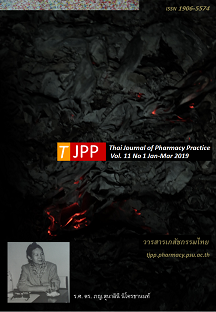ผลของการจัดการเรียนรู้แบบห้องเรียนกลับด้านร่วมกับกิจกรรมการจัดการเรียนรู้ แบบร่วมมือในรายวิชาเภสัชวิทยา หัวข้อยาที่ใช้ในความผิดปกติของต่อมไทรอยด์
Main Article Content
บทคัดย่อ
วัตถุประสงค์: เพื่อประเมินผลของการจัดการเรียนรู้แบบห้องเรียนกลับด้านร่วมกับกิจกรรมการเรียนรู้แบบร่วมมือในชั้นเรียนต่อความรู้ของผู้เรียน วิธีการ: การวิจัยนี้เป็นการศึกษากึ่งทดลอง กลุ่มตัวอย่าง คือ นิสิตเภสัชศาสตร์ชั้นปีที่ 3 มหาวิทยาลัยนเรศวร จำนวน 89 คนที่เรียนวิชาเภสัชวิทยา 2 การแทรกแซง คือ การจัดการเรียนรู้แบบห้องเรียนกลับด้านร่วมกับกิจกรรมการจัดการเรียนรู้แบบร่วมมือ การจัดการเรียนการสอนประกอบด้วย 2 กิจกรรม ได้แก่ 1) กิจกรรมก่อนเข้าชั้นเรียน ผู้เรียนศึกษาเนื้อหาด้วยตนเองในหัวข้อยาที่ใช้ในความผิดปกติของต่อมไทรอยด์ผ่านสื่อการเรียนรู้ ได้แก่ วิดีโอคลิป เอกสารประกอบการสอน และเอกสารคำสอนที่ผู้สอนแจกให้ 2) กิจกรรมในชั้นเรียน เป็นกิจกรรมการเรียนรู้แบบร่วมมือโดยแบ่งผู้เรียนเป็นกลุ่มละ 4-5 คน ผู้สอนแจกคำถามแปดข้อและกระดาษคำตอบแบบขูดให้กลุ่มผู้เรียน ต่อมาผู้เรียนอภิปรายกลุ่มก่อนตอบคำถามลงในกระดาษคำตอบ ตามด้วยการอภิปรายในชั้นเรียนเพื่อหาคำตอบร่วมกับผู้สอน การศึกษานี้ประเมินความรู้ของผู้เรียนเป็นรายบุคคลก่อนและหลังการเข้าร่วมกิจกรรมในชั้นเรียน ใช้สถิติ Wilcoxon singed rank test ในการประเมินความแตกต่างของคะแนนทดสอบย่อยรายบุคคลก่อนและหลังการเข้าร่วมกิจกรรมในชั้นเรียน ผลการวิจัย: ผู้เรียนมีคะแนนทดสอบย่อยเพิ่มขึ้นอย่างมีนัยสำคัญทางสถิติจาก 6.62±1.17 คะแนนจากคะแนนเต็ม 8 ในช่วงก่อนเข้าร่วมกิจกรรมในชั้นเรียนเป็น 7.55±0.67 (P<0.001) ผู้เรียนที่มีเกรดเฉลี่ยสะสมมากกว่า 3.40 ในช่วงต้นเทอมและเกรดในรายวิชาเภสัชวิทยา 1 ตั้งแต่ B+ มีคะแนนทดสอบย่อยก่อนเข้าร่วมกิจกรรมในชั้นเรียนมากกว่ากลุ่มที่เกรดสะสมและเกรดในรายวิชาที่ต่ำกว่า อย่างมีนัยสำคัญทางสถิติ (P<0.001) ภายหลังจากเข้าร่วมกิจกรรมในชั้นเรียน พบว่ากลุ่มผู้เรียนที่มีเกรดเฉลี่ยสะสมและเกรดในรายวิชาเภสัชวิทยา 1 แตกต่างกัน มีคะแนนทดสอบย่อยไม่แตกต่างกัน (P>0.35 และ P>0.52 ตามลำดับ) สรุป: การจัดการเรียนรู้แบบห้องเรียนกลับด้านร่วมกับกิจกรรมการเรียนรู้แบบร่วมมือในชั้นเรียนช่วยส่งเสริมให้ผู้เรียนมีความรู้เพิ่มขึ้น
Article Details
ผลการวิจัยและความคิดเห็นที่ปรากฏในบทความถือเป็นความคิดเห็นและอยู่ในความรับผิดชอบของผู้นิพนธ์ มิใช่ความเห็นหรือความรับผิดชอบของกองบรรณาธิการ หรือคณะเภสัชศาสตร์ มหาวิทยาลัยสงขลานครินทร์ ทั้งนี้ไม่รวมความผิดพลาดอันเกิดจากการพิมพ์ บทความที่ได้รับการเผยแพร่โดยวารสารเภสัชกรรมไทยถือเป็นสิทธิ์ของวารสารฯ
เอกสารอ้างอิง
2. Chalarux N. The teacher's role and instruction in the 21st century. FEU Academic Review. 2015;9: 64-71.
3. Sattrapruek S. Flipped classroom in 21st century learning for development of learning and innovation skills. Academic Services Journal Prince of Songkla University 2017; 28: 100-8.
4.Duangpummes W, Kaewurai W. Learning manage ment in Thailand 4.0 with active learning. Humanities and Social Sciences Journal of Graduate School, Pibulsongkram Rajabhat University. 2017;11:1-13.
5. Suthasinobol K. Flipped classroom. Bangkok: P.S. Pattana.; 2015.
6. Diewtrakul N. Using flipped classroom in teaching English in tertiary level. Sripatum Review of Huma nities and Social Sciences. 2017;17: 137-45.
7. See S, Conry JM. Flip my class! A faculty develop ment demonstration of a flipped-classroom. Curr Pharm Teach Learn 2014;6: 585-8.
8. Munson A, Pierce R. Flipping content to improve student examination performance in a pharmaco genomics course. Am J Pharm Educ 2015;79: 103. doi: 10.5688/ajpe797103.
9. Pierce R, Fox J. Vodcasts and active-learning experiences in a flipped classroom model of a renal pharmacotherapy module. Am J Pharm Educ 2012 ;76:196. doi: 10.5688/ajpe7610196.
10. Terri H. Wong, Eric J. Ip, Ingrid Lopes, Rajagopalan V. Pharmacy students’ performance and perceptions in a flipped teaching pilot on cardiac arrhythmias. Am J Pharm Educ 2014; 78: 185. doi: 10.5688/ajpe781 0185.
11. Giuliano CA, Moser LR. Evaluation of a flipped drug literature evaluation course. Am J Pharm Educ. 2016 ; 80: 66. doi: 10.5688/ajpe80466.
12. O'Flaherty J, Phillips C. The use of flipped class rooms in higher education: A scoping review. The Internet and Higher education. 2015;25:85-95.
13. McLaughlin JE, Roth MT, Glatt DM, Gharkholonare he N, Davidson CA, Griffin LM, et al. The flipped classroom: a course redesign to foster learning and engagement in a health professions school. Acad Med 2014; 89: 236-43.
14. Kim MK, Kim SM, Khera O, Getman J. The experi ence of three flipped classrooms in an urban university: an exploration of design principles. The Internet and Higher Education. 2014;22:37-50.
15. Johnson DW, Johnson RT, Holubec EJ. Coopration in the classroom. Edina, MN: Interaction Book Company; 2008.
16. Kemmanee T. Teaching science: knowledge for effective learning management. Bangkok: Chulalong korn University Press; 2010.
17. Rotellar C, Cain J. Research, perspectives, and recommendations on implementing the flipped class room. Am J Pharm Educ. 2016; 80: 34. doi: 10.5688 /ajpe80234.
18. Moffett J. Twelve tips for “flipping” the classroom. Med Teach 2015; 37:331-6.
19. Sharma N, Lau CS, Doherty I, Harbutt D. How we flipped the medical classroom. Med Teach 2015; 37: 327-30.
20. Hew KF, Lo CK. Flipped classroom improves stu- dent learning in health professions education: a meta-analysis. BMC Med Educ 2018;18:38. doi: 10.1186/s12909-018-1144-z.
21. Puanduang A, Siriwatchaiporn R. Application of cooperative learning in the nursing ethics and laws course. Journal of Boromarajonani College of Nursing Bangkok. 2015;31: 123-9.
22. Pulbutr P, Saramunee K, Anusornsangiam W, Cush nie B, Jaruchotikamol A. Effects of flipped classroom learning model in the lessons on pharmacology of anti-diabetic agents in pharmacy students at Mahasarakham University. Thai Journal of Pharmacy Practice 2017; 9: 422-32.


